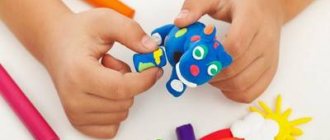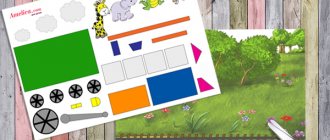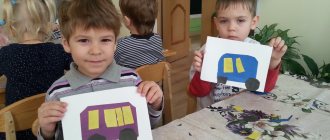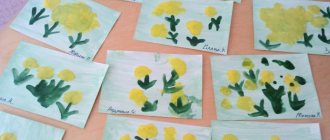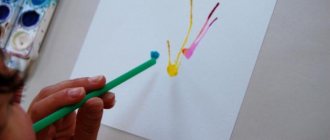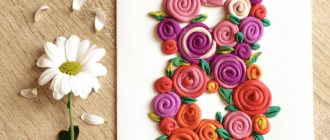Applications for children are one of the most favorite games and fun. But it’s by playing that the little ones learn! They gradually become accustomed to the world of colors and shapes. And they also get satisfaction from the fact that they themselves, with their own hands, can create beauty. And if parents want to help their child, we will give you ideas for appliqué made from colored paper.
What we can offer:
- Schemes and stencils for applications of different figures: flowers, animals, insects and fairy-tale characters.
- We'll show you what interesting, non-traditional appliqué techniques there are.
- And, of course, we will give you a lot of positive emotions! We are sure you will have fun with us!
And most importantly, all these children's applications are for toddlers of different ages. And in one year the child will be interested in playing, and the older one will enjoy this activity. Why? Because we have prepared a collection that includes applications for children with different abilities.
The essence of the concept
Applique (from the Latin applicatio - application) is a type of visual technique in which an image is obtained by applying or attaching elements of paper, fabric or other material to a base that serves as the background for the picture.
According to the Federal State Educational Standard (FSES), in a preschool educational institution (DOU), application is an important element of children’s productive activities. Therefore, this type of visual technique must be mastered in kindergarten, regardless of the educational program on which the preschool educational institution operates. The only differences are in the form of presentation of this type of work. For example, if a kindergarten works according to the “Childhood” program, where all classes are grouped around a common theme in a certain period of time, then there will not be much thematic diversity in the applications, and therefore a wide range of mastery of techniques. A different situation is observed in preschool educational institutions working under the “Origins” program, where the different pace of psychological development of children is taken as a basis, and in this regard, a special role is given to the individualization of work with children, including through involvement in completing tasks together with their parents. For example, in the senior group, one of the tasks for an art project may be to prepare a project in the form of an application on the topic “Traffic Rules”.
Depending on the complexity of the application, the project can be short-term - up to a week, or long-term - up to a month
Goals of conducting classes on applications according to the Federal State Educational Standard
The mission of introducing this type of visual technology into the educational process of preschool educational institutions is:
- activation of fine motor skills - in younger groups this contributes to the rapid development of speech, and in older and preparatory groups it helps prepare the hand for writing;
- development of imaginative thinking (especially in the middle group, when kids begin to perform applications not only according to the model, but also based on their own ideas - the so-called tasks on “free topics”);
- developing the ability to work according to a model (in the younger group this helps expand the experience of children, and in the older group it accustoms them to the main form of work in elementary school);
- activation of the vocabulary (children replenish their vocabulary with new words and terms, for example, learn the meaning of words such as “pattern”, “plane image”, etc., and also practice the ability to formulate questions as they complete the task, develop the ability to give verbal evaluation of one’s own and others’ work);
- development of the ability to navigate in space and visual attention (kids practice placing parts exactly within the boundaries of the image contour, remembering the technique for doing this depending on the material - for example, placing a cut-out paper part is easier than “getting” into the boundaries of the contour with cut threads or grains);
- nurturing a positive attitude towards productive activities (regardless of the age group, in the process of work, children learn to solve emerging difficulties, focusing on obtaining the desired result, for example, if in the older group, in the process of completing an application on the topic “Bullfinch on a snow-covered branch,” a child had difficulties with gluing snow from cotton wool onto cardboard, it makes sense to try doing it with a different type of glue or “placing it” on double tape).
Appliqué work instills in children a positive attitude towards working in a team
Table: application tasks in preschool educational institutions for different age groups
| Group | List of tasks |
| First youngest |
|
| Second youngest |
|
| Average |
|
| Senior and preparatory |
|
Hedgehog
Applications for the little ones are creativity, where the abilities of even the tiniest fidget are taken into account. And this example with the “hedgehog” is just right for toddlers who, by the age of three, still cannot cut and glue, but they will be great at participating in the work. How?
- There are two options for preparing to make this applique for kids. First
.
We trace the baby's palm on a sheet of black or brown paper. Cut it out. Glue it. Four palms will be enough. Second option
. Or we use finger paints. The child dips his palm, and we help him put his palm in this way several times, at different angles in the upward direction, to make a fan. - Cut out something like a boat from paper of the same color. This is the body and nose of the hedgehog (cut out a small circle and glue the “nose” to the edge of the muzzle).
- We place the body under the “needles”.
- You can draw a mouth and an eye, or make semicircles from red and white paper. Don't forget about the pupils.
- Paper applications would be incomplete without a plot. We come up with a story with the baby. Our hedgehog is coming from the forest, so we’ll cut out and glue his “prey”: an apple and a mushroom.
- We complement the paper applique with small black paws.
Application as a topic for teacher self-education
Self-education is an important means of teacher professional development. In the practice of preschool educational institutions, topics on self-education affect all (!) areas of the educational process. Including the development of children within the framework of the artistic and aesthetic direction of the educational process. In this context, teachers study the possibilities of various visual techniques in realizing the teaching, developmental and educational goals of preschool education. In this sense, the application opens up a wide field for activity, since:
- has many types;
- practiced from the first junior group;
- can be used in classes of any direction (FEMP, speech development, FCCM, etc.);
- allows you to solve several educational problems at once (for example, children develop spatial thinking, logic, fine motor skills, creativity, etc.).
As for building a scheme for working on a self-education topic related to an application, it remains unchanged and includes three stages:
- theoretical (study of methodological literature on the topic);
- practical (implementation of theory in practical activities);
- reporting (summarizing, drawing up reports - printed, photo and video).
In the process of implementing the practical stage of mastering the topic, the teacher applies theoretical knowledge, and this combination is analyzed in the report on the work done
Approximate list of topics for self-education on application
There are topics of a more general nature, and there are more specific ones:
- “Development of creative abilities in preschool children using applications.”
- “Non-traditional techniques of visual activities (applications) in kindergarten.”
- “Appliqué as a means of developing fine motor skills of children of primary school age.”
- “Development of fine motor skills in children of older different age groups in visual activities (applications).”
- “Non-traditional materials in appliqué as a means of artistic expression for children.”
Applications for children 4-5 years old
At this age, colored paper applications and templates for them become more complex. By preparing, together with an adult, elements for a future picture, the child shows more independence: cuts, selects colors and, thus, gains an understanding of composition.
This activity develops logical thinking and allows you to show creative inclinations.
For children 4-5 years old, a fun activity is making cards, which they then give to their parents and friends.
The base is folded in half and elements are glued inside the postcard to form a plot picture.
The templates developed by specialists are only examples indicating the direction of work.
Parents and educators can contribute their ideas. For example, using a cut out outline of a baby’s palm in an applique – such pictures evoke amazement and delight in children.
Applications with palm
The technique of appliqué using only circles reveals for the child the relationship between the parts and the whole.
When developing a child’s creative imagination, you should show him various techniques for working with paper: for example, folding it in the shape of an accordion. For such a picture you need to prepare a base and draw contours. The gluing process also becomes more complicated.
Literature on applications to help teachers
To facilitate the process of preparing application classes, the teacher can use the following sources:
- Gribovskaya A.A. Application in kindergarten, - M.: Scriptorium, 2010.
- Grigorieva G.G. Visual activities of preschool children. - M.: Publishing House, 1997;
- Gusakova M.A. Application, - M.: “Enlightenment”, 1982;
- Korotkova E.A. Drawing and application in kindergarten, - M.: Academy of Development, Harvest, 2009;
- Methods of visual activity and design classes / edited by T.S. Komarova, - M.: “Enlightenment”, 1985;
- Methods of teaching drawing, modeling and application in kindergarten / edited by Sakkulina N.P. – M.: “Enlightenment”, 1971;
- Novikova I.V. Volumetric application in kindergarten, - M.: 2011;
- Pogateeva Z.A. Applique classes in kindergarten, - M.: “Prosveshcheniye”, 1988;
- Rumyantseva E.A. Application. Simple crafts, - M.: World of Books, 2010.
- Sakkulina N.P., Komarova T.S. Visual activities in kindergarten, - M.: “Prosveshchenie”, 1982.
Application in kindergarten occupies a special place in the educational process, as it allows you to realize the important goals of the educational process in a preschool educational institution, on the one hand, and on the other hand, children are involved in this type of work with great pleasure - the process of making picture elements even fascinates them more than a focus on getting results. From the position of a teacher, the application, among other things, also opens up wide opportunities for developing topics for self-education.
Materials for applications
The most popular material for applique is paper. As a basis, you can take simple colored, wrapping, corrugated, foil, self-adhesive, kraft paper, and also use a variety of clippings from magazines and notebook covers.
Often the basis for such crafts is used:
- cereals and dried plant seeds (rice, sunflower seeds, peas, beans);
- dried leaves of trees and shrubs, flower petals;
- small shells, small pebbles;
- sand;
- plasticine;
- felt;
- buttons;
- cotton wool, cotton pads.
Naturally, to create an applique you will need scissors; you can use simple stationery or curly ones that will make the edges of the paper in a certain pattern. You can use shaped hole punches to create small, neat shapes (butterfly, tree leaf, heart, star). PVA glue, glue stick, and silicone glue are good for gluing.
